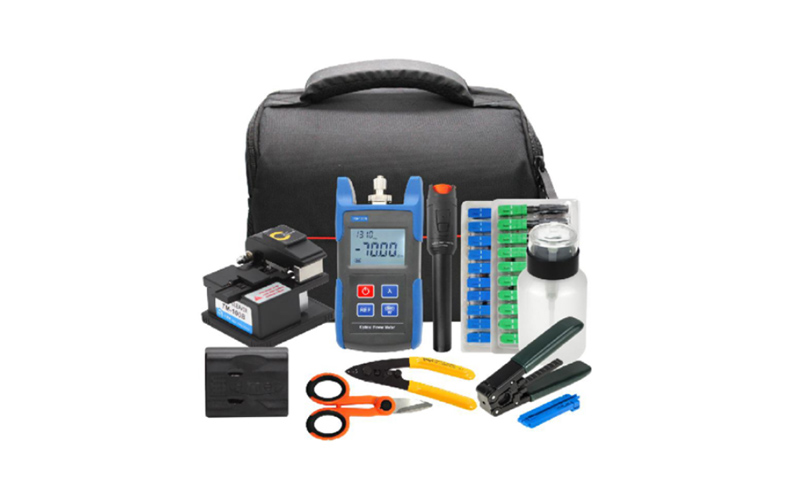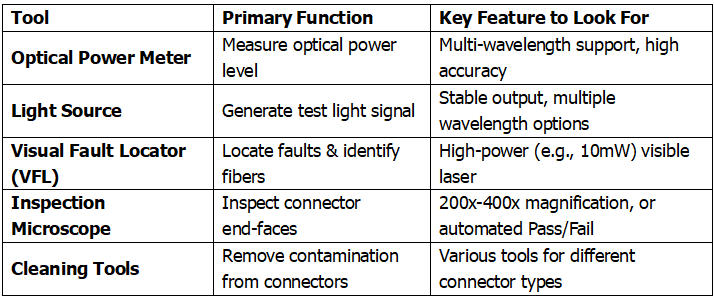
A comprehensive kit integrates several key tools to perform a wide range of tests and procedures.
✅ Optical Power Meter (OPM)
Function: Measures the absolute power (in dBm or mW) of an optical signal transmitted through a fiber. This is the fundamental tool for testing signal strength and calculating insertion loss (the loss of light power when passing through a cable link).
Key Features: Look for a meter that supports multiple wavelengths (e.g., 850nm, 1300nm, 1310nm, 1490nm, 1550nm) to be compatible with various network equipment and single-mode/multimode fibers. Some models offer automatic wavelength identification and calibration features.
✅ Optical Light Source (OLS)
Function: Generates a stable light signal at specific wavelengths, which is injected into one end of the fiber. The Power Meter is used at the far end to measure the received power, allowing for loss calculation.
Key Features: Kits may include a laser-based source for single-mode applications (e.g., 1310/1550nm) or an LED-based source for multimode applications (e.g., 850/1300nm). Higher-end kits often include a visual fault locator (VFL) function built into the source.
✅ Visual Fault Locator (VFL)
Function: Emits a bright visible red laser light (typically 650nm) into the fiber. This light will shine through the cable jacket at the location of a break, severe bend, or poor connection, allowing for easy visual identification of faults. It is also excellent for fiber identification and tracing.
Key Features: Common output powers are 1mW or 10mW; higher power can make faults easier to see over longer distances. It often features continuous, pulsed, and slow-pulsing modes.
✅ Fiber Inspection Microscope
Function: Critically important for examining the end-face of fiber optic connectors for contamination (dust, oils) and damage (scratches, pits). Contamination is a leading cause of network failures.
Key Features: Available in optical (e.g., 200x-400x) and video versions. Advanced automated inspection scopes like the FI-7000 FiberInspector™ Pro can provide a one-second Pass/Fail certification against industry standards, eliminating human subjectivity.
✅ Essential Preparation and Cleaning Tools
Most professional kits also include tools for cable preparation and cleaning, which are vital for proper installation:
Strippers: For removing the cable's outer jacket (e.g., Cable Jacket Slitter 3, Rotary Cable Stripper 6), buffer tubes, and fiber coating.
Cleaning Tools: Including pen-style cleaners 3, cleaning cassettes 7, and optical cleaning sticks 7 to remove contaminants from connector end-faces before inspection and mating.
✅ Scribes, Cutters, and Pliers: Tools like Kevlar scissors 3 and armored tubing cutters 6 for cutting strengthening members and trimming fibers.
✅ Consumables: Such as connector wipes, alcohol, and polishing films.

Types of Kits and Their Applications
Test kits are often bundled for specific tasks or user levels.
✅ Basic Verification & Troubleshooting Kits
These kits are designed for field technicians who need to quickly verify light levels, check for continuity, and find faults. They typically center around a power meter and light source combo (like the IDEAL FiberMASTER 5 or the L-com TBX51MM 6) and often include a VFL and basic cleaning tools. They are perfect for network installations, cable maintenance, and inspection.
✅ Advanced Certification & Installation Kits
These are comprehensive kits for technicians who install and certify new fiber optic links. They include all the verification tools above plus more sophisticated equipment like OTDRs (Optical Time Domain Reflectometers) for detailed characterization of the entire fiber length and pinpointing exact fault locations 12. They also include a full suite of splicing, termination, and preparation tools (e.g., strippers, crimp tools, polishing pucks 6).
✅ FTTH/GPON Specialized Kits
With the growth of Fiber-to-the-Home, kits tailored for these networks have emerged. They feature power meters with wavelengths specific to PON networks (e.g., 1490nm for downstream data and 1310nm for upstream data) 57. An example is the TTK001A kit, which includes an OPM, OLS, VFL, microscope, and cleaning tools specifically for FTTx maintenance.

© 2024-2026 ARTIC FIBER OPTIC CO.,LTD. All Rights Reserved.